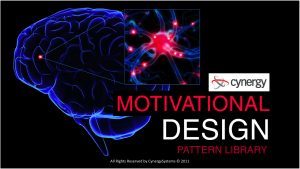 I have spent a lot of time over the past few months pondering and incubating the concepts of Motivational Design (MD). What I love most about MD is that it is a metaphor for its own principles and patterns. Initially the potential impact of MD was most obvious to me in context of improving employee and customer experience, but soon after I realized that was just scratching the surface.
I have spent a lot of time over the past few months pondering and incubating the concepts of Motivational Design (MD). What I love most about MD is that it is a metaphor for its own principles and patterns. Initially the potential impact of MD was most obvious to me in context of improving employee and customer experience, but soon after I realized that was just scratching the surface.
A quote MD uses to help illustrate one of its patterns is:
“All decisive advances in the history of scientific thought can be described in terms of mental cross-fertilization between different disciplines.” Arthur Koestler
Motivational Design is a pattern library and process framework developed by Kes Sampanthar of Cynergy. In essence this library of patterns can also be described in terms of mental cross-fertilization between different disciplines. They leverage the rich intelligence formed within the gaming discipline to extract patterns for increasing the wanting. Cross-fertilizing that with insights from behavioral economics and more explicitly the cognitive patterns that shape our motivations. Further adding the advances made with regards to reach and awareness that social media has provided. This is a powerful combination and a decisive advancement bridging the gap between our intent and our results in the experiences we create.
Much of Kes’s work with Motivational Design thus far has been in context of developing engaging user experiences for technology solutions. However, I strongly believe these patterns are equally as applicable to every aspect of business and life broadly. In fact they are arguably easier to apply elsewhere.
I will share examples from 2 of the MD patterns to illustrate some of the concepts but I believe it is the sum of the parts, using multiple patterns, that breeds it’s potency. Each pattern on it’s own is useful but not unique, nor ground breaking, it is the union of them along with it’s process framework that makes MD so brilliant.
Some car manufacturers have started to add eco gauges that visually display if you are driving efficiently using leaves; the more green leaves you have the more efficient you are driving.
This example immediately had me thinking about medical therapy adherence which is a costly both in terms of fiscal costs and quality of life. I have previously seen solutions much like household alarms used to try to achieve these results but I would imagine a “gamified” approach would better address the intent to increase the wanting to adhere.
Example #2:
If a runaway trolley is about to run over five people walking on the tracks. You are standing next to a switch that can turn the trolley onto a side track, killing one person, but allowing the five to survive, what do you do? Chances are you would kill one over five.
Yet if five people have just been rushed into a hospital in critical care, each requiring an organ to survive. There is not enough time to request organs from outside the hospital. There is, however, a healthy person in the hospital’s waiting room. If the surgeon takes this person’s organs, he will die but the five in critical care will survive. Should he kill the one person to save the five? Pretty sure we would all say no.
Same results different moral circumstances. Yet we seldom consider the cognitive patterns of decision making, we tend to shape our strategies based on logical decision behaviour.
We see examples of this time and again with incentive programs intended to make customers or employees happy but in the end generating disappointment resulting from cognitive responses. Incorporating MD would mitigate unintended outcomes and dramatically improve our intended experiences.
Smart brands like eBay and Callaway Golf and many more have leveraged Cynergy’s Motivational Design to maximize their user experiences. This is much more than theory, it works!



